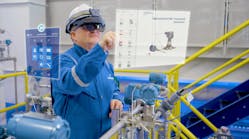The introduction of automation technology in industrial operations is playing an ever-increasing role in the safety of personnel and equipment. Automation has enabled manufacturers to create systems that can detect potential hazards before they arise, improving safety procedures and protecting workers in dangerous environments.
The advantages of integrating this technology into the workplace are clear, but implementing industrial automation for improved safety outcomes may take some time.
When starting out, manufacturers should carefully assess the specific needs and risks of their facility to determine which automation technology could best suit their operations. A best practice is to begin by looking at what tasks are labor-intensive and repetitive — these are prime candidates for automation.
Your business may be grappling with the challenges of integrating new technologies into old legacy systems. This is when partnering with a company that specializes in automation technologies can really prove to be valuable, as these organizations can help to make sure you are effectively leveraging existing architecture and connectivity with new automation solutions.
Some of the most common automation solutions include LiDAR systems, robotics, safe motion devices and hazardous point sensors.
Unlocking the potential of LiDAR technology in collaborative robotics
Robotics and sensors are two key areas of automation that have been developed over the past several years.
LiDAR technology, the use of light detection and ranging, has revolutionized collaborative robotics as it is now used to provide enhanced mapping capabilities in complex and hazardous environments. This type of robotic cognition can enable robots to precisely determine their location, orientation and the physical characteristics of their surroundings.
By creating a 3D map of the environment, LiDAR enables robots to accurately perceive obstacles and changes in the terrain ahead. It also allows robots to better understand how objects interact with each other to safely carry out tasks that are too dangerous or difficult for people to do themselves.
Harnessing the power of safe motion technology
Safe motion technology is a remarkable innovation that allows for more efficient and safer operations in industrial settings. With the implementation of advanced sensors and computer vision algorithms, production can be monitored in real time and automated safety protocols can be triggered when certain parameters are exceeded.
This technology works by using sensors to monitor various facets of an operation, such as speed, power levels, temperature and pressure. When any of these metrics exceed predetermined thresholds, the sensors send alerts to the system's artificial intelligence (AI) algorithms which then analyze the data and determine if any action needs to be taken. If deemed necessary, automated safety protocols are triggered to adjust certain parameters back into safe ranges.
Safe motion technology can be used in a wide variety of production and manufacturing settings, including controlling automated assembly lines, where it can help regulate the speed of robotic arms. This type of technology is also commonly utilized by machine operators when carrying out precision tasks, such as welding, ensuring that any hazardous sparks or molten metal are not in contact with additional workers or materials.
Utilizing advanced hazardous point sensors
Hazardous point sensors are a critical component of modern industrial production and manufacturing. These sensors detect a wide range of potentially hazardous conditions, such as high temperature, pressure, humidity and radiation.
Hazardous point sensors are becoming increasingly sophisticated, allowing them to identify even smaller changes in environmental conditions. For example, it is now possible to detect even the slightest fluctuations in air quality or pressure that could be potentially hazardous. This level of detail allows operators or technicians to implement preventive measures before any real problems occur.
Achieving robust safety in collaborative robot workstations
Kundinger provided a cutting-edge safety application for a client that allowed for efficient and safe collaborative workspaces between humans and robots. Utilizing laser monitoring devices, safe motion drives and motors, the team was able to create an environment where complex robotic operations could take place without putting workers in harm's way.
The lasers used in this project served multiple purposes. By allowing the robots to work closely with humans, they created a more efficient workflow compared to the traditional use of perimeter guards or segmented facilities. Additionally, Kundinger provided several safety features such as speed control, emergency stops and safety limits that increased operational accuracy while working with robots.
To further improve safety, Kundinger also implemented drives and motors that enabled quick response time in the event of an emergency. This proved invaluable as it allowed any robotic operation to be halted immediately if risk is detected. As a result, employees can work alongside robots with significantly less risk.
Mitigating risk with protocols and training
Automation is not a “set it and forget it” solution for safety. A safe, comprehensive system, whether it is brand new or a complement to legacy equipment, considers all potential hazards and addresses them with appropriate protocols and training for staff.
When designing solutions for customers, Kundinger considers the human factor; this involves looking at how people interact with the system and making sure there are no areas that put employees at risk of harm. For example, factors such as clear signage, adequate lighting, effective communication of procedures and the availability of protective equipment all come into play when assessing safety risks in the workplace.
Additionally, it is important to have systems in place that provide feedback on performance and track progress towards meeting safety objectives. This ensures any issues are identified quickly and corrective action can be taken as soon as possible.
Maximizing benefits of automation: How employees can lead the way
When transitioning to automated solutions, it is essential to ensure that employees are on board with the changes. Automation is not meant to replace human workers or downsize workforce, but rather it is about supplementing human workers by providing them with more efficient and safer workflows.
By involving employees in the process from the start, they can better understand how automation can help to improve their day-to-day operations. Demonstrating the tangible benefits of automation allows employees to recognize how it can support them in their roles, allowing them to work confidently and competently within an automated environment.
Automation solutions are valuable investments that, when designed and utilized effectively, can provide numerous benefits to workplace safety. By reducing the risk of human error and providing a reliable and consistent approach, automation can help prevent accidents and injuries in the workplace, ultimately leading to a safer and more productive work environment.
Michael Kundinger is a vice president of Kundinger Inc., a Wisconsin and Michigan-based company delivering fluid power, automation, process control, products and solutions to a wide range of industries. He has been with the company for 16 years and during that time has held positions in engineering and sales. His current role is focused on industrial and factory automation, helping companies leverage the latest automation technologies to achieve business goals like improved production cycle times, reduced time to market and accelerated return on investment. He is a graduate of Kettering University (formerly General Motors Institute) with a degree in Mechanical Engineering.


